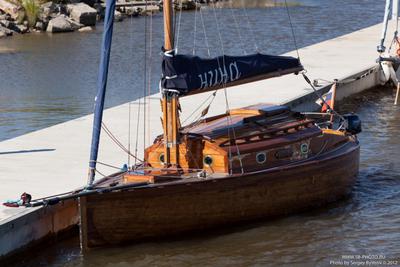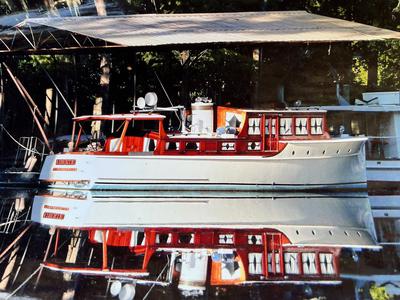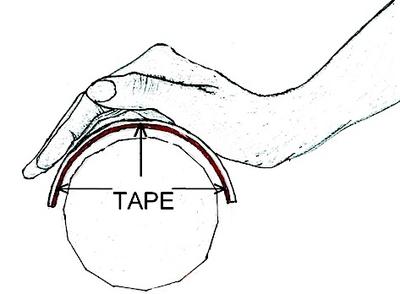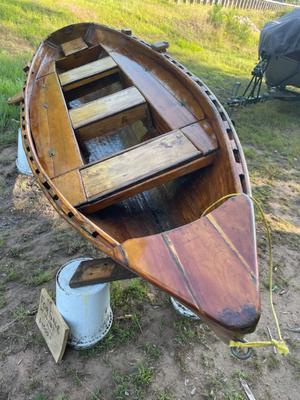- Home
- Your Boats
- This Page
Sailing Yacht NINA
by Roman Artamonov
(Russia St Petersburg)

An historic yacht, that was bought in 1994 and restored completely within 12 years using the original photos and materials.
One of the main goals was to be able to sail it possibly alone.
Sails and use of fins were built so it would be possible to control from the cockpit.
In 2012 the work was completed.
The oldest document about the yacht was from the yacht club "Trud" in 1997, issued paper is available, which, inter alia, recording the main dimensions of the boat (L 7400 mm B 2200 mm, T 1400mm (with extended sword), the year of construction (1898) and the country of origin (Germany).
Dimensioned drawings subsequently were produced.
Documentation:
A historical photo series shows a doubleender with cabin and cockpit coaming.
The hull is of yellowish wood (oak), cabin made of reddish wood (mahogany), coaming and uppermost strake are also made of this materials.
The underwater hull was not colored with antifouling paint.
Before the cabin, mast trunks are made of yellowish wood (oak or ash), also there are stands with cleats.
In coaming there are two slots that can be seen with brass bezel.
Under the body surface there is a platform for the widening of the tail, as well as a pendent engine mount.
Both have been retrofitted.
Under the flat, dinghy cruiser like hull with a steep Steven sits a flat, long keel, at the end of an oar with rudder blade (galvanized) is cultivated.
The rudder trunk is guided by the rear.
On the boat it can be seen the hull registration is N - 36, a name (NEVA) and at the rear the words "Trud" and including (presumably club and home port), in Cyrillic script in white reading "Moskva".
The two chain plates protrude in height of mast trunks on both sides next to the outer skin of the side deck.
The conclusion of the running deck makes FUS rails, generously provided with scuppers.
In each sides of cabin there are two small oval window.
In front of the cabin there two round windows, all with brass mounts.
The cabin roof is painted white, it has a circular arc shape and two handrails, which are each supported by three metal frames on distance to the roof.
A sliding hatch with washboards form the conclusion aft. (Sliding hatch can be seen on old photo from the 50s).
In addition to the plug-schott there is a small round hole (receptacle for a tool).
The deck beams of cabin roof consist of mutually bonded light and dark woods.
On the foredeck is a square wooden bollard.
The design of the boat and the construction work was done professionally, as is it was drawn by a designer and built by a boatyard.
Joists and planks are obviously riveted (as an inspection inside of the boat was confirming).
The boat itself was next to other boats nestled in a hall, on car tires.
The photo was already in color and should therefore probably come form early 1960s.
On another photoset demolition can be seen.
The running deck, fore and aft, as well as the cabin roof are already removed, as well as the cockpit benches, the platform with the engine mount and the mast trunks.
Another series of photographs devoted to the gradual reconstruction.
The upper strake has been re-exported in mahogany, which stern closed, confiscated the deck beams and constructed the side walls of the cabin to the cockpit coaming.
Only a few pieces boards were renewed.
The ribs lying in the bilge area were almost completely removed from bow to stern and new scarfing the remaining ribs.
In addition, new floor timbers were drafted into the bilge.
There was only one photo that shows the boat under sail.
These were a gaff rig with a long, towering over the stern tree with a small jib.
A white cabin roof can be seen, 2 oval window in the cabin roof that protrudes from the rear tiller and a skirting board beneath the topmost plank Ganges, continuously from bow to stern, can be seen.
The black and white photo was taken in 1950s on the Klyasma river in Russia.
The restored boat in comparison with the original:
Comparing the finished boat with the views of the shootings, great match can be seen with the original design has been restored, the old cabin with the coaming and the arched roof was installed again, the mast is installed at the old place.
The keel plus rudder system, the sword and dagger board have the old original format.
The rudder trunk is located at the old place.
Looking at the trunk and the cabin walls exactly covered one of the many, carefully incorporated bungs, an indication that much original substance has been preserved.
Mast, boom and forestay are again made of wood.
Differences from the 1960 views are in detail:
Neither the running deck, yet the cabin roof nor the hull are designed in different colors.
Where wood has been processed, the surface remained untreated or was impregnated with a special blend of epoxy and alcohol (according to Mr Swetlaev).
Subsequently, the mahogany and oak timbers were coated (similar to a fiberglass fabric) and again painted with a film layer with epoxy resin.
Cabin roof, running deck and cockpit benches were occupied by kind of teak decks with oak strips, left untreated and sealed with grout.
The individual rods were screwed directly onto the deck beams (without plywood as a base) and shed the joints.
Fittings, rudder blade, and sword were made exclusively in brass or stainless steel as a special production.
The cleats are made of solid brass individually.
An essential and striking difference is the rig, Mr Swetlaev opted for a high rigging (Mainsail and jib) gennaker pole.
All the controls in the form of colorful rope run modern stanchion into the cockpit.
The mainsail falls, led by Lazy-Jacks, covered in a navy blue sail dress outside the white lettering NINA shows.
Even the sword is hard to control from the cockpit.
At the rear, a small outboard was attached.
Below decks the boat is tastefully decorated with seat cushions and old-fashioned kerosene lamps.
A chemical toilet is cleverly hidden under a mahogany door.
A pantry with cooker, mat and boiler was installed.
Equipped is the boat with the necessary ropes, anchor (stainless material), life jackets, etc. – everything you need for sailing.
Also, worth mentioning the refusal of the mast below deck by means of rods of stainless material still to the front and to the side walls to dissipate the forces at the base of the mast.
Conclusion: Mr Swetlaev without doubt has managed to have preserved the originality of the boat as far as possible using historical material.
This particular as regards the hull and the deck layout.
The use of modern materials such as epoxy resin, brass, stainless material and naturally oak on the running deck and cabin roof is certainly due to the desire to reduce the labor intensity in winter storage on a minimum and thus understood.
The extremely modern rig the gennaker pole and the extensive diversion into the cockpit seems strange when you know that the body should come from the year 1898 but who wants to make his boat regatta capable will have to resort to such measures.
For those who want to operate only cruising sail, the boat could be disarmed - without gennaker, with linen-colored sails, monochrome rope, reduced deflection and blocks of wood.
As long as no documents of a boatyard or a designer show would be found, the origins of the "NINA" will remain hidden in the darkness of history.
It is possible both that the boat has been built from the outset as type keel centreboard Jollenkreuzer, as has also been retrofitted with keel and cabin.
The sleek foredeck and the flat shape of the hull suggests that the boat was given from the outset as a leisure boat in order, in order to sail fast and sporty (so it was not working boat for fishing or similar).
Design and construction point to the professional work of a boat building operation.
Something was executed between the turn of the century (1900) and the beginning of WW2.
Of these boats are hardly any survived (the authors are not known).
Also in the German Shipping Museum in Bremerhaven, none of these types of boats is shown.
"Nina" is one of these types of boats.
In this respect, the "NINA" an extraordinary and very rare example for small sailboats from the period of the early 20th century in Germany.
The photographic evidence should reach both as evidence of the original structure, as well as the faithful reconstruction.
Thus, it has definitely value the possibility to have to be preserved for posterity.
For the purpose of the circle of friends, it would be preferable to continue under sail in his initially planned element to move the water.
If that is not possible, a museum should be found, which presents this extraordinary treasure from the past and durable - documented its history - taking into account its specific resume.
Using somewhat stricter criteria the rig could be set back in the direction of origin and return some color to the boat.
Comments for Sailing Yacht NINA
|
||
|
||
Want to add more photos?
Photo Uploader
If you are having problems uploading Photos or would like to add more click on this link for the Upload Form.














